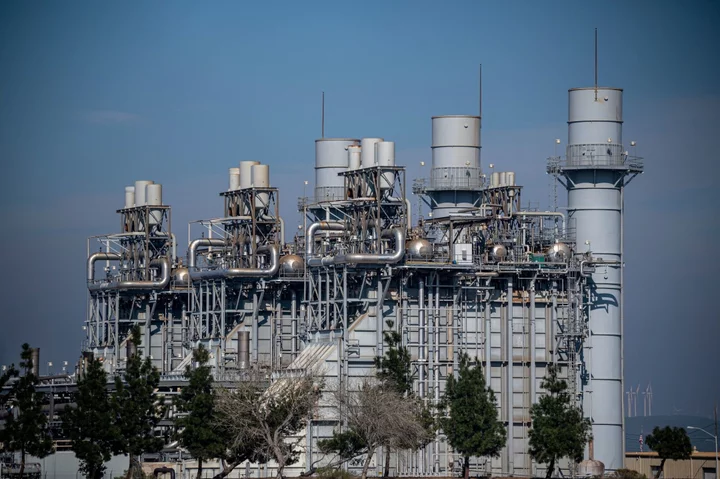The top lobbying group for US electric utilities is taking aim at the Biden administration’s plan for stifling greenhouse gas emissions from the nation’s power plants, saying proposed requirements are based on technology that isn’t ready for prime time.
In comments being filed with the federal government Tuesday, the Edison Electric Institute argues the Environmental Protection Agency overestimates the affordability and readiness of carbon-capture systems and hydrogen that would be compelled for large natural gas-fired power plants, despite being rarely used in the sector today.
The EPA “simultaneously downplays the various infrastructure challenges to deploying these technologies, while overplaying the current state of deployment and demonstration of each technology,” the group of investor-owned utilities said in its filing. “Neither CCS nor hydrogen blending are adequately demonstrated today as they are not deployable, available or affordable across the entirety of the industry.”
The industry criticism underscores the political and economic challenges facing the Biden administration as it seeks to impose what would become the first-ever US limits on planet-warming pollution from the nation’s existing fleet of natural gas-fired power plants. Throttling those emissions is critical to meet US climate commitments — but a Supreme Court ruling last year limited the EPA’s latitude to force sweeping changes across the sector, spurring the agency’s more narrow focus on technologies that can be applied at individual sites instead.
The EPA’s proposal would require many large, frequently run gas-fired power units to replace 30% of their fuel with cleaner-burning hydrogen by 2032 or install carbon-capture systems by 2035. Coal-fired power plants could keep operating without new pollution curbs as long as they close by 2032 — or 2035, if they ran far less frequently.
Many power utilities have championed CCS and hydrogen for years, touting the technologies as critical to decarbonizing the sector — and environmental advocates have seized on EEI’s position as evidence of hypocrisy. “The utility industry has talked more about these fossil-fuel solutions than all renewable energy technologies combined,” Leah Stokes, a University of California Santa Barbara environmental politics professor, said in a Los Angeles Times opinion piece.
Environmentalists are lobbying the administration to go further. Evergreen Action and 28 other green groups told the government the EPA should accelerate its timelines for existing gas-fired power facilities. “Plants do not need 12 or 15 years to comply with emissions standards,” they say in a filing. “Abatement technologies like carbon capture are commercially available now.”
The Natural Resources Defense Council and Clean Air Task Force, meanwhile, argue the EPA should expand the pool of existing gas-fired power facilities that are subject to the requirements, by concentrating on large plants run 45% of the time. The shift could compel changes at roughly 30% more gas plants nationwide — but prevent 78% more covered emissions.
“The electric power industry has a long history of objecting to new pollution control requirements as they are proposed, but then outperforming those requirements once they are set,” the groups say. “Many companies have set and are expected to meet corporate decarbonization commitments that exceed or are close to what this proposal would require.”
The Edison Electric Institute, whose members include Consolidated Edison Inc., Dominion Energy Inc., FirstEnergy Corp. and Southern Company, says carbon capture and hydrogen technologies don’t represent the “best system of emission reduction” for natural gas-fired units — a legal threshold under the Clean Air Act.
While carbon-capture systems have been used for decades and are increasingly deployed to trap emissions at industrial facilities, just two coal plants now supplying US grids employ the technology commercially. No gas-fired power plants do, though a Massachusetts facility ran the technology at the turn of the century and there are plans to restart the Texas Petra Nova coal unit that trapped CO2 before its 2020 closure.
Read More: Biden’s Power Plant Rule to Hinge on Little-Used Carbon Capture
EEI argues the EPA is underestimating the time needed to deploy critical infrastructure that undergirds carbon capture and hydrogen blending, such as pipelines to transport those gases. And electric companies aren’t confident the technologies will hit performance and cost targets in the proposed timeline anyway, EEI says, creating “obstacles to continued emissions reductions” and impacting utilities’ “efforts to deliver affordable and reliable electricity to customers.”
The trade group doesn’t question the EPA’s authority to regulate greenhouse gas emissions from the nation’s power plants — a stance that puts it at odds with some Republican lawmakers and attorneys general. “EEI and our member companies support regulations for GHG emissions,” the group’s president, Tom Kuhn, said in a news release. The goal, he said, is requirements that provide “maximum flexibility” and are legally durable.
Some of the trade group’s members, such as Constellation Energy Corp., are highlighting their support for the EPA proposal amid pressure from environmentalists. In a news release Monday, Constellation Chief Executive Officer Joe Dominguez praised the agency’s proposal as flexible, saying it builds on approaches already in use. Constellation cited tests earlier this year on one of its gas plants in Alabama showing it could safely operate burning 40% hydrogen.
Other comments:
- Thirty Democratic senators pushed the EPA to finalize the requirements by March next year, arguing the proposed standards are “necessary to slow climate change and protect public health, required by law, and are both achievable and highly affordable.”
- The National Rural Electric Cooperative Association argued the EPA is pushing “unrealistic timelines” and “unachievable” standards “that are so unproven and aspirational” they would force coal plants to shut down prematurely. While carbon capture is promising, it’s a “nascent” technology that “has not been shown to work at a commercial scale on either coal or natural gas units.”
Author: Jennifer A. Dlouhy

